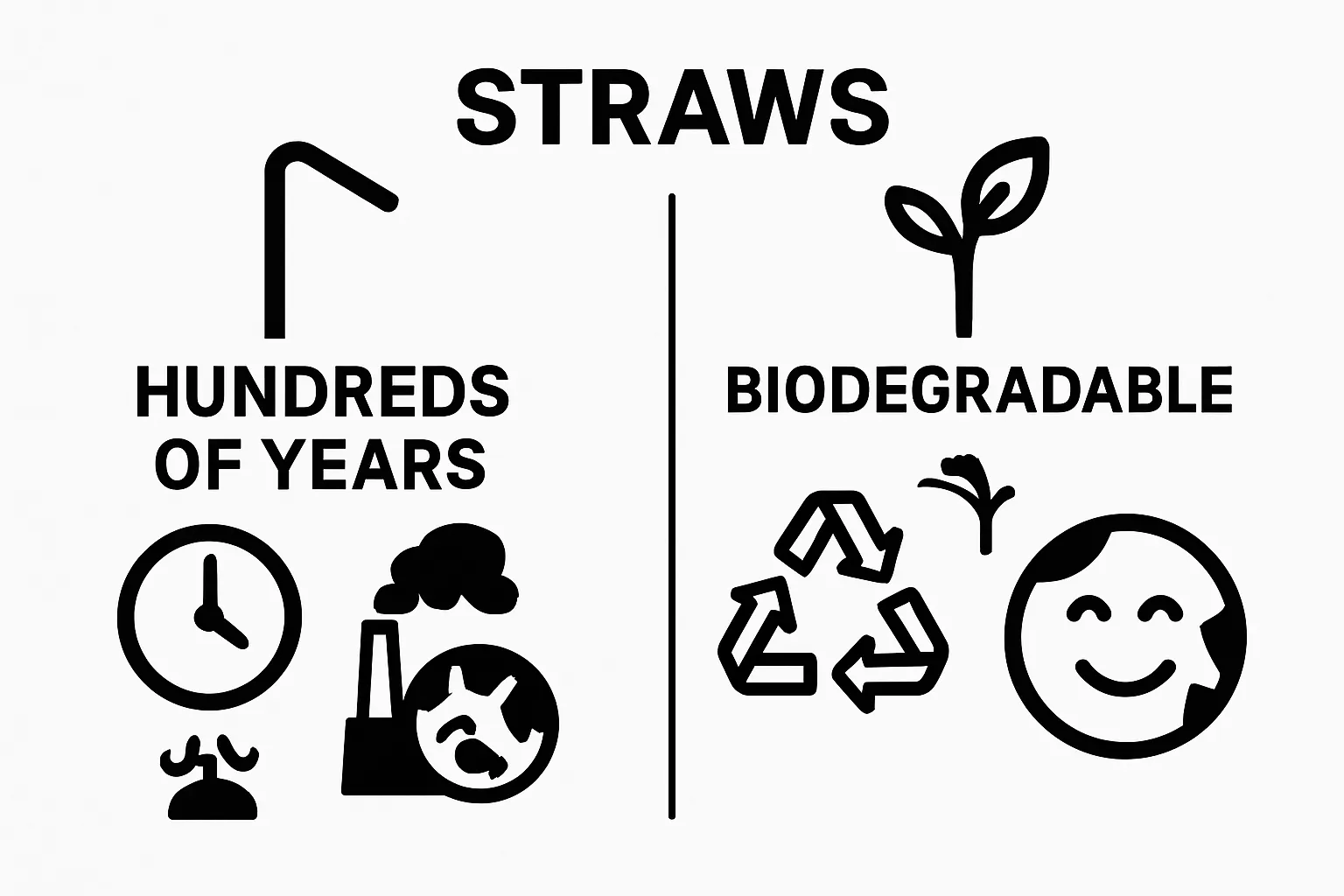Understanding the Environmental Impact of Straws

Straws might seem like ordinary drinking tools found in every cafe and kitchen, but their impact runs much deeper. Imagine this. Millions of plastic straws are discarded across the globe every single day, and most of them end up polluting our oceans or piling up in landfills. The real surprise is that something so small and simple can actually spark conversations about sustainability and drive massive change in how we treat our environment.
Table of Contents
- What Are Straws And Their Usage?
- The Environmental Effects Of Straw Production
- The Impact Of Plastic Straws On Marine Life
- Alternatives To Plastic Straws And Their Benefits
- How Straws Fit Into Broader Sustainability Goals
Quick Summary
| Takeaway | Explanation |
|---|---|
| Plastic straws harm marine ecosystems significantly | Millions of plastic straws contribute to marine pollution, causing injury and death to marine life through ingestion and entanglement. |
| Sustainable alternatives reduce environmental impact | Plant-based straws can cut waste by up to 80%, promoting biodegradability and reducing reliance on fossil fuels during production. |
| Straws reflect broader waste management issues | Addressing straw usage helps highlight larger environmental concerns and encourages businesses to adopt comprehensive sustainability strategies. |
| User experience remains intact with eco-friendly straws | Modern plant-based straws offer comparable durability and convenience to traditional options, ensuring consumer satisfaction while being environmentally responsible. |
What are Straws and Their Usage?
Straws are thin, cylindrical tubes designed for transferring liquid from a container directly into a person’s mouth. These simple yet ubiquitous tools have been part of human consumption patterns for centuries, evolving from natural materials like plant stems to modern manufactured versions.
The Basic Function of Straws
At their core, straws serve a fundamental purpose of liquid transportation. They allow individuals to drink beverages without tilting containers, providing convenience and minimizing potential spills. From soft drinks to smoothies, straws have become an integral part of global beverage consumption across various settings like restaurants, cafes, and home environments.
The typical straw design involves a hollow tube with a narrow diameter, usually between 0.2 to 0.3 inches wide. Learn more about our sustainable straw solutions that are transforming how businesses approach liquid consumption accessories.
Environmental Considerations of Straw Usage
Traditional plastic straws have significant environmental implications. According to research from the Ocean Conservancy, millions of plastic straws are discarded daily worldwide, contributing substantially to global plastic waste. These single-use items often end up in marine environments, posing serious threats to aquatic ecosystems.
Key environmental concerns surrounding traditional straws include:
- Slow decomposition rates spanning hundreds of years
- Potential harm to marine wildlife through ingestion and entanglement
- Contribution to microplastic pollution in oceans and waterways
- Limited recyclability due to their small size and material composition
Understanding these environmental impacts highlights the critical need for sustainable alternatives that maintain user convenience while minimizing ecological damage.
Below is a comparison of traditional plastic straws and plant-based straw alternatives, highlighting their environmental impact and user experience, as discussed in the article.
| Attribute | Plastic Straws | Plant-Based Straws |
|---|---|---|
| Material | Petroleum-based polymer | Renewable plant materials |
| Decomposition Time | Hundreds of years | Naturally decompose much faster |
| Marine Impact | High—cause ingestion, entanglement, and pollution | Low—minimize marine ecosystem disruption |
| Recyclability | Limited, mostly unrecyclable | Often compostable or biodegradable |
| Carbon Footprint | High due to fossil fuel extraction and production | Lower due to renewable sources |
| User Experience | Durable and convenient | Modern versions offer comparable durability |
| Contribution to Microplastics | Significant | Minimal |
| Brand Sustainability Perception | Negative | Enhanced brand reputation |
The Environmental Effects of Straw Production
Straw production, particularly plastic straw manufacturing, represents a complex environmental challenge with far-reaching consequences. The process involves multiple stages of resource extraction, manufacturing, and distribution that collectively contribute to significant ecological impacts.
Raw Material Extraction and Processing
The initial stage of straw production begins with raw material procurement. For plastic straws, petroleum-based polymers are the primary component, requiring extensive fossil fuel extraction. Explore our sustainable alternatives for hospitality industries that minimize these environmental burdens.
According to research from the National Center for Biotechnology Information, plastic straw production generates substantial carbon emissions. The manufacturing process consumes significant energy resources, releasing greenhouse gases and contributing to global climate change.
Carbon Footprint and Energy Consumption
The environmental impact of straw production extends beyond material extraction. Manufacturing processes demand considerable energy, typically sourced from non-renewable fossil fuels. Each stage of production generates carbon emissions, from raw material processing to final product packaging and transportation.
Key environmental challenges in straw production include:
- High energy consumption during polymer processing
- Significant greenhouse gas emissions
- Water resource depletion during manufacturing
- Chemical waste generation from production processes
Waste Generation and Long-Term Environmental Consequences
Beyond production, straws create substantial waste management challenges. Most single-use straws cannot be effectively recycled due to their size and material composition. This leads to environmental accumulation, with millions of straws ending up in landfills and marine ecosystems annually.
The long-term environmental consequences of straw production are profound.
This table summarizes the key environmental effects of plastic straw production, breaking down the challenges associated with each phase of the lifecycle as described in the content.
| Production Phase | Environmental Challenge | Specific Impact |
|---|---|---|
| Raw Material Extraction | Fossil fuel depletion | Petroleum extraction for plastic production |
| Manufacturing | High energy and water consumption | Carbon emissions, water depletion, chemical waste |
| Distribution | Additional energy use | Fuel for transportation adds to carbon footprint |
| Post-Use Waste | Limited recyclability, landfill buildup | Accumulation in ecosystems, hundreds of years to decompose |
| End-of-Life Impact | Long-term resource loss | Persistent pollution impacting wildlife and habitats |
The Impact of Plastic Straws on Marine Life
Plastic straws represent a significant threat to marine ecosystems, causing devastating environmental consequences that extend far beyond their seemingly innocuous appearance. These small, ubiquitous items have become a critical component of global marine pollution, causing substantial damage to underwater habitats and marine organisms.
Direct Ingestion and Physical Harm
Marine animals frequently mistake plastic straws for food, leading to catastrophic physical consequences. Sea turtles, seabirds, and marine mammals often consume these non-biodegradable objects, which can cause internal blockages, severe digestive complications, and ultimately, death. Learn about our sustainable ocean protection strategies that aim to mitigate these environmental risks.
According to research from the National Oceanic and Atmospheric Administration, approximately 8 million metric tons of plastic enter marine environments annually, with straws comprising a significant portion of this pollution.
Microplastic Contamination and Ecosystem Disruption
As plastic straws degrade, they break down into microplastics tiny fragments less than 5 millimeters in size that permeate marine food chains. These microscopic particles are ingested by plankton, fish, and other marine organisms, creating a cascading effect of environmental contamination.
Key environmental impacts of plastic straws on marine ecosystems include:
- Disruption of marine food webs
- Potential transmission of toxic chemicals through biological systems
- Reduced reproductive capabilities in marine species
- Long-term genetic and physiological alterations in marine populations
Long-Term Ecological Consequences
The persistent nature of plastic straws means they can remain in marine environments for hundreds of years.
This prolonged presence creates ongoing challenges for marine ecosystems, including habitat destruction, chemical leaching, and sustained biological interference.
The cumulative impact extends beyond immediate physical harm, potentially compromising entire marine biodiversity frameworks. By understanding these complex ecological interactions, we can recognize the urgent need for sustainable alternatives that protect our oceans and the intricate life systems they support.
Alternatives to Plastic Straws and Their Benefits
The global movement towards sustainable beverage consumption has catalyzed innovative alternatives to traditional plastic straws. These eco-friendly solutions aim to maintain user convenience while dramatically reducing environmental impact and supporting marine conservation efforts.
Plant-Based Straw Technologies
Plant-based straw technologies represent a transformative approach to sustainable drinking accessories. These alternatives leverage renewable materials that naturally decompose, providing a practical solution to single-use plastic pollution. Discover our comprehensive range of sustainable straw solutions designed for environmentally conscious businesses and consumers.
According to research from the Environmental Protection Agency, plant-based alternatives can reduce waste accumulation by up to 80% compared to traditional plastic straws.

Environmental and Economic Advantages
Sustainable straw alternatives offer multifaceted benefits that extend beyond environmental preservation. These innovative solutions provide economic advantages for businesses by addressing growing consumer demand for eco-friendly products and demonstrating corporate environmental responsibility.
Key benefits of sustainable straw alternatives include:
- Reduced carbon footprint
- Faster biodegradation rates
- Lower production energy requirements
- Minimal marine ecosystem disruption
- Enhanced brand reputation for sustainability
Performance and User Experience Considerations
Modern sustainable straw technologies have significantly improved in durability, functionality, and user experience. Unlike early iterations, contemporary plant-based straws maintain structural integrity during use, providing a comparable drinking experience to traditional plastic straws.
The evolution of sustainable straw technologies reflects a broader commitment to innovative environmental solutions. By embracing these alternatives, businesses and consumers can actively contribute to marine conservation, reduce plastic waste, and support a more sustainable global ecosystem.
How Straws Fit into Broader Sustainability Goals
Straws represent more than just a singular product category they serve as a powerful symbolic entry point for broader sustainability conversations and systemic environmental transformation. By addressing straw consumption, businesses and consumers can initiate meaningful dialogues about waste reduction, resource conservation, and ecological responsibility.
Microcosm of Global Waste Management
Plastic straws function as a microcosm of larger global waste management challenges. Their small size and ubiquitous nature make them an ideal starting point for understanding complex environmental issues. Explore our comprehensive sustainability approach that extends beyond individual product solutions.
According to research from the World Economic Forum, transitional products like sustainable straws can help organizations develop more holistic waste reduction strategies.
Catalyst for Behavioral Change
Sustainable straw alternatives serve as a catalyst for broader behavioral modifications in consumer consumption patterns. By introducing environmentally conscious products, businesses can gradually shift consumer expectations and normalize sustainable purchasing decisions.
Key sustainability transformation opportunities include:
- Raising environmental awareness
- Demonstrating practical sustainable alternatives
- Encouraging corporate responsibility
- Promoting circular economy principles
- Inspiring systemic innovation
Strategic Environmental Engagement
Implementing sustainable straw solutions represents a strategic approach to environmental engagement. These small yet significant changes create ripple effects across supply chains, manufacturing processes, and consumer consciousness. Organizations can leverage straw alternatives as tangible demonstrations of their commitment to ecological stewardship.
By integrating sustainable straw technologies, businesses communicate their dedication to comprehensive environmental strategies.
 This approach transcends mere product replacement, positioning sustainability as a core organizational value that extends across operational practices and corporate philosophy.
This approach transcends mere product replacement, positioning sustainability as a core organizational value that extends across operational practices and corporate philosophy.
Make Sustainable Choices with The Ocean Straw
You have learned just how damaging traditional straws are for our environment, especially for our oceans and marine life. The article explores how everyday choices, like using single-use straws, can quickly add up to a much bigger environmental problem. If you want to help reduce waste and protect marine ecosystems, making the switch to safer alternatives really matters.
Explore The Ocean Straws and discover how our plant based and compostable straws can make a meaningful difference for your business and our planet. These innovative solutions deliver the same level of convenience while supporting your sustainability goals.

Ready to lead your industry and inspire your customers to choose better? Visit The Ocean Straw Growth Pack to see options that fit your HoreCa needs and join the movement for cleaner oceans. Act now by exploring more at theoceanstraw.com and help create a cleaner future, one straw at a time.
Frequently Asked Questions
What are the environmental impacts of traditional plastic straws?
Traditional plastic straws contribute significantly to plastic pollution, taking hundreds of years to decompose, posing threats to marine life, and generating microplastics that disrupt ecosystems.
How do plant-based straws compare to plastic straws in terms of environmental sustainability?
Plant-based straws are more environmentally sustainable than plastic straws as they are made from renewable materials that decompose faster, reducing waste accumulation and the overall carbon footprint.
What are some alternatives to plastic straws, and how do they benefit the environment?
Alternatives to plastic straws include plant-based straws and reusable metal or silicone straws, which can significantly reduce environmental impact by decreasing plastic waste and promoting sustainable consumption habits.
How can individuals contribute to reducing the environmental impact of straw usage?
Individuals can reduce environmental impact by choosing sustainable straw alternatives, minimizing single-use plastic consumption, and advocating for eco-friendly practices in their communities.